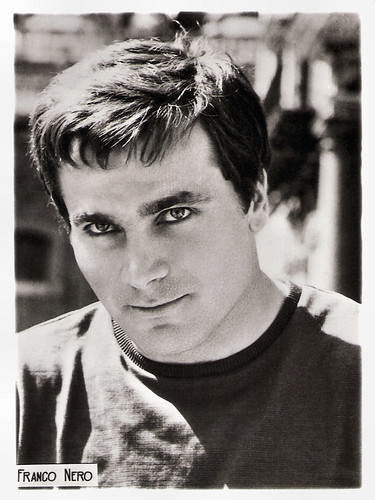
Small Romanian card by Cooperativa Fotografia.
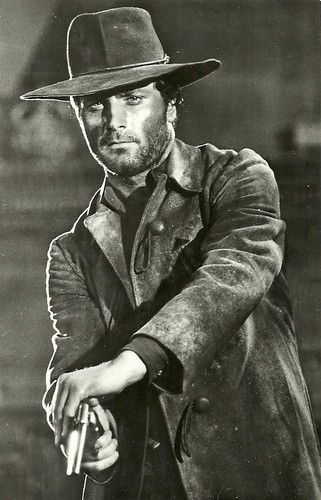
Romanian postcard by Casa Filmului Acin. Photo: Publicity still of Franco Nero in Texas, Adios/Goodbye, Texas (Ferdinando Baldi, 1967). In Germany the film was presented as Django 2 or Django, der Rächer, though it was not a sequel to the box office hit Django (1966).
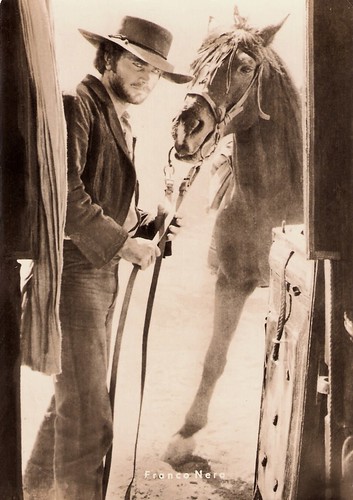
East-German postcard by VEB Progress Film-Vertrieb, Berlin, no. 211/70, 1970. Retail price: 0,20 M. Photo: publicity still for L'uomo, l'orgoglio, la vendetta/Man, Pride & Vengeance (Luigi Bazzoni, 1968).
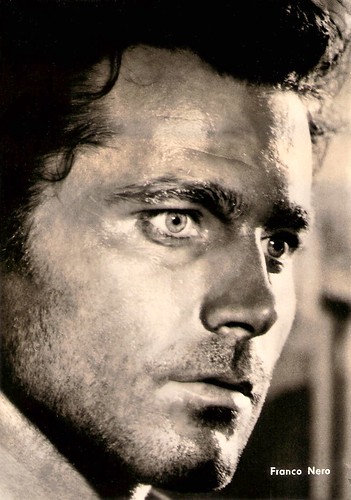
East-German postcard by VEB Progress Film-Vertrieb, no. 108/71, 1971.
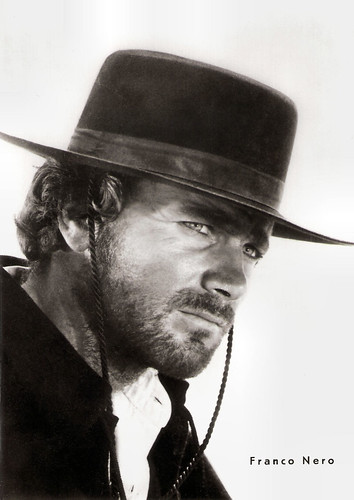
East-German postcard by VEB Progress Film-Vertrieb, no. 28/77.
An Angel of Death
Franco Nero was born Francesco Sparanero in San Lazzaro in the Province of Parma, Italy, in 1941. He grew up in Bedonia, a northern Italian provincial town as the son of a strict police sergeant.
Nero studied briefly at the Economy and Trade faculty of Milan University, before leaving to study at the Piccolo Teatro di Milano. During that time, he was also appearing in fotoromanzi, the popular Italian photo-novels.
His film debut was an appearance in Pelle viva/Living Skin (Giuseppe Fina, 1962). He then played bit parts in such comedies as La ragazza in prestito/Engagement Italiano (Alfredo Giannetti, 1964) with Rossano Brazzi, and La Celestina P... R.../Celestial Maid at Your Service (Carlo Lizzani, 1965) with Assia Noris.
A year later, Nero’s handsome face was noticed by John Huston who chose him for the role of Abel in the extravagant production La bibbia/The Bible: In the Beginning... (1966).
But his breakthrough was the role of the lonely gunfighter, dragging a coffin behind him through a muddy and featureless landscape, in Django (Sergio Corbucci, 1966). The coffin, his dark coat, and the mystique around Django make him appear like an angel of death.
Buzz McClain at AllMovie: "When the Italian movie studios saw Sergio Leone's A Fistful of Dollars (1965) making dollars by the fistful they began rolling out Spaghetti Westerns by the conestoga load. One of the earliest efforts is still one of the genre's best, Sergio Corbucci's Django, a spare, hard-bitten, mean-spirited shot of pure adrenaline that counts Quentin Tarantino as one of its cult members (he stole the ear-cutting torture scene for Reservoir Dogs)."
That year Nero starred in a total of eight films, including the Spaghetti Westerns Texas, addio/Adios, Texas (Ferdinando Baldi, 1966) and Tempo di massacro/The Brute and the Beast (Lucio Fulci, 1966).
Nero made his Hollywood debut as Sir Lancelot in Alan Jay Lerner and Frederick Loew’s musical Camelot (Joshua Logan, 1967). During the filming he met actress Vanessa Redgrave, who became his long-time partner. But the film was a disaster. Alexandre Paquin at FilmCritic.com: "Franco Nero's casting was a mistake, as his poor English leads him to talk slowly, and he does not seem to know how to sound realistic in English. In spite of his good looks, he looks completely out of place in this production, and even physically, his performance looks exaggerated."
A lack of proficiency in English tended to limit his Hollywood roles, although he would appear in more English language films including The Virgin and the Gypsy (Christopher Miles, 1970) and Force 10 from Navarone (Guy Hamilton, 1978) starring Harrison Ford.

Romanian postcard by Casa Filmului Acin.

Romanian postcard by Casa Filmului Acin. Photo: publicity still for Gente di rispetto/The Flower in His Mouth (Luigi Zampa, 1975) with Jennifer O'Neill.
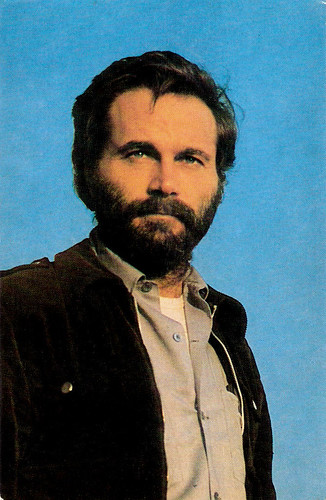
Russian postcard, no. 109/76, 1976. Price: 5 Kop. Photo: N. Slezingera.
Romanian postcard by Casa Filmului Agin. Publicity photo for La Salamandra/The Salamander (1982).
Romanian postcard by Casa Filmului Acin.
Django Lives!
Handsome Franco Nero appeared opposite the equally beautiful Claudia Cardinale in the mafia film Il giorno della civetta/The Day and the Owl (Damiano Damiani, 1968). In the late 1960s and during the 1970s, Nero often appeared in such political thrillers, which criticized the Italian justice system.
Then he played with Catherine Deneuve in Luis Buñuel's masterpiece Tristana (1970). In the war drama Bitka na Neretvi/The Battle of Neretva (Veljko Bulajic, 1969) he starred with Yul Brynner and Russian actor-director Sergei Bondarchuk. Later, Bondarchuk cast Nero for the role of famous American reporter John Reed in the two-part epic Krasnye kolokola II/Red Bells (Sergei Bondarchuk, 1982).
Although Franco Nero was often typecast as the hero in Italian action films he also attempted an impressive range of non-heroic or psychologically complex characters. He starred as a strict and possibly psychotic young officer in Marcia trionfale/Victory March (Marco Bellocchio, 1976), as a white ninja in Enter the Ninja (Menahem Golan, 1981) and as a gay lieutenant in Rainer Werner Fassbinder’s Querelle (1982) in love with the sailor Querelle (Brad Davis) - a compelling performance.
At the beginning of the 1980s, Nero also began producing, writing and directing. He both wrote and starred in Jonathan degli Orsi/Jonathan of the Bears (Enzo G. Castellari, 1984). In 1990 he played terrorist General Esperanza, opposite Bruce Willis in Die Hard 2 (Renny Harlin, 1990). Nero starred in Hungarian director Gábor Koltay's Honfoglalás/The Conquest (1996), and subsequently in his Sacra Corona/Holy Crown (Gábor Koltay, 2001).
During his career, Nero appeared in over 150 films, and in between he participated in various theatrical events. He also works for charitable organizations. Franco Nero and Vanessa Redgrave separated for many years, during which they both had relationships with other people. In 1987, while filming in Cartagena, Colombia, he was involved in an affair with Mauricia Mena and fathered a son named Franquito.
Franco Nero and Vanessa Redgrave reunited and married in 2006. Their son Carlo Gabriel Sparanero (1969) is a screenwriter and director, known professionally as Carlo Nero. Franco and Vanessa were directed by their son in Uninvited (1999). They also appeared together in the romantic comedy Letters to Juliet (Gary Winick, 2001).
Recent films with Franco Nero are the horror film The Rite (Mikael Håfström, 2011) with Anthony Hopkins and Cars 2 (John Lasseter, Brad Lewis, 2011) in which he voiced Uncle Topolino. And Nero made a cameo appearance in Quentin Tarantino's Django Unchained (2012). He is expected to return as Django in Django Lives (Joe D'Augustine, 2015) and opposite other veteran Spaghetti Western stars like John Saxon, Bud Spencer and Tomas Milian in Keoma Unchained (2016) by Enzo G. Castellari.
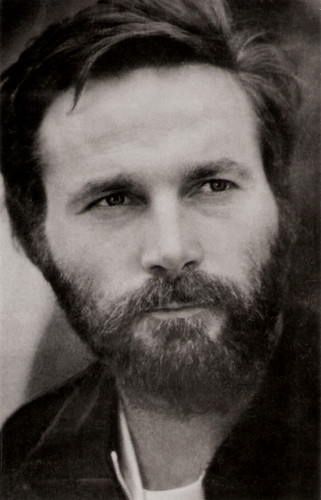
Russian postcard, no. 758.
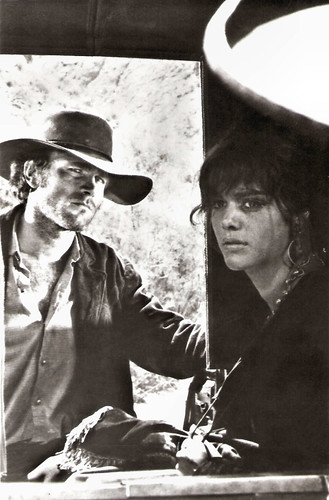
Romanian postcard by Casa Filmului Acin. Photo: publicity still for L'uomo, l'orgoglio, la vendetta/Man, Pride & Vengeance (Luigi Bazzoni, 1967) with Tina Aumont.

Romanian postcard by Casa Filmului Acin. Photo: publicity still for L'uomo, l'orgoglio, la vendetta/Man, Pride & Vengeance (Luigi Bazzoni, 1967).
Trailer Django (Sergio Corbucci, 1966). Source: PickOfTheFlicks Tony (YouTube).
Trailer Keoma (Enzo G. Castellari, 1976). Source: Moloch (YouTube).
French trailer for Querelle (RaINER Werner Fassbinder, 1982). Source: Gaumont (YouTube).
Trailer Die Hard II (Renny Harlin, 1990). Source: Forever Cinematic Trailers (YouTube).
Sources: Hal Erickson (AllMovie), Buzz McClain (AllMovie), Tzvetislav Samardjiev (IMDb), Wikipedia and IMDb.
1 comment:
I loved seeing him in Letters to Juliet, and slowly realizing as I watched the film that he was Redgrave's old love. I'd lost track of him and his career. Camelot is one of my favorite musicals.
Post a Comment